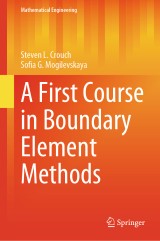Details

A First Course in Boundary Element Methods
Mathematical Engineering
|
106,99 € |
|
| Verlag: | Springer |
| Format: | |
| Veröffentl.: | 22.07.2024 |
| ISBN/EAN: | 9783031633416 |
| Sprache: | englisch |
Dieses eBook enthält ein Wasserzeichen.
Beschreibungen
<p>This textbook delves into the theory and practical application of boundary integral equation techniques, focusing on their numerical solution for boundary value problems within potential theory and linear elasticity. Drawing parallels between single and double layer potentials in potential theory and their counterparts in elasticity, the book introduces various numerical procedures, namely boundary element methods, where unknown quantities reside on the boundaries of the region of interest. Through the approximation of boundary value problems into systems of algebraic equations, solvable by standard numerical methods, the text elucidates both indirect and direct approaches. Indirect methods involve single or double layer potentials separately while direct methods combine these potentials using Green's or Somigliana's formulas. The two approaches give comparable results for general boundary value problems. Tailored for beginning graduate students, this self-contained textbook offers detailed analytical and numerical derivations for isotropic and anisotropic materials, prioritizing simplicity in presentation while progressively advancing towards more intricate mathematical concepts, particularly focusing on two-dimensional problems within potential theory and linear elasticity.</p>
<p>1. An Illustration of the Boundary Element Approach.- 2. Potential Theory.- 3. The Direct Boundary Integral Method for Laplace’s Equation.- 4. Elasticity.- 5. The Stress Discontinuity Method.</p>
<p>Steven L. Crouch, Professor Emeritus in the Department of Civil, Environmental, and Geo-Engineering at the University of Minnesota, is a distinguished member of the National Academy of Engineering. Serving as Dean of the College of Science and Engineering from 2005 to 2016, Crouch has made significant contributions to academia and research. His expertise lies in boundary element methods, particularly in the field of geoengineering and composite materials. His research interests focus on the development of boundary integral methods for modeling elastic and viscoelastic materials with inhomogeneities and voids, as well as for transient heat conduction and thermoelasticity in nonhomogeneous materials. His work stands at the forefront of advancing understanding and application in these critical areas of study.</p>
<p>Sofia Mogilevskaya, a distinguished research professor at the University of Minnesota's Department of Civil, Environmental, and Geo-Engineering, earned her Ph.D. from the Scotchinsky Research Institute of Mining, Russian Academy of Sciences, Moscow, in 1987. With expertise in applied mathematics and computational mechanics, she focuses on geomaterials and composite materials. Her work involves developing numerical algorithms for simulating fracture propagation and studying material behavior at both microscopic and macroscopic levels. Her research finds applications in mining, hydraulic fracturing, and material design. Beyond research, she is a dedicated educator, guiding graduate students and fostering their growth. </p>
<p>Sofia Mogilevskaya, a distinguished research professor at the University of Minnesota's Department of Civil, Environmental, and Geo-Engineering, earned her Ph.D. from the Scotchinsky Research Institute of Mining, Russian Academy of Sciences, Moscow, in 1987. With expertise in applied mathematics and computational mechanics, she focuses on geomaterials and composite materials. Her work involves developing numerical algorithms for simulating fracture propagation and studying material behavior at both microscopic and macroscopic levels. Her research finds applications in mining, hydraulic fracturing, and material design. Beyond research, she is a dedicated educator, guiding graduate students and fostering their growth. </p>
<p>This textbook delves into the theory and practical application of boundary integral equation techniques, focusing on their numerical solution for boundary value problems within potential theory and linear elasticity. Drawing parallels between single and double layer potentials in potential theory and their counterparts in elasticity, the book introduces various numerical procedures, namely boundary element methods, where unknown quantities reside on the boundaries of the region of interest. Through the approximation of boundary value problems into systems of algebraic equations, solvable by standard numerical methods, the text elucidates both indirect and direct approaches. Indirect methods involve single or double layer potentials separately while direct methods combine these potentials using Green's or Somigliana's formulas. The two approaches give comparable results for general boundary value problems. Tailored for beginning graduate students, this self-contained textbook offers detailed analytical and numerical derivations for isotropic and anisotropic materials, prioritizing simplicity in presentation while progressively advancing towards more intricate mathematical concepts, particularly focusing on two-dimensional problems within potential theory and linear elasticity.</p>
Provides in-depth derivations of key mathematical solutions Distinguishes itself from conventional boundary element method texts Offers essential solutions and algorithm insights
Diese Produkte könnten Sie auch interessieren:

Neutron Applications in Earth, Energy and Environmental Sciences

von: Liyuan Liang, Romano Rinaldi, Helmut Schober

149,79 €

Nanobioelectronics - for Electronics, Biology, and Medicine

von: Andreas Offenhäusser, Ross Rinaldi

96,29 €














